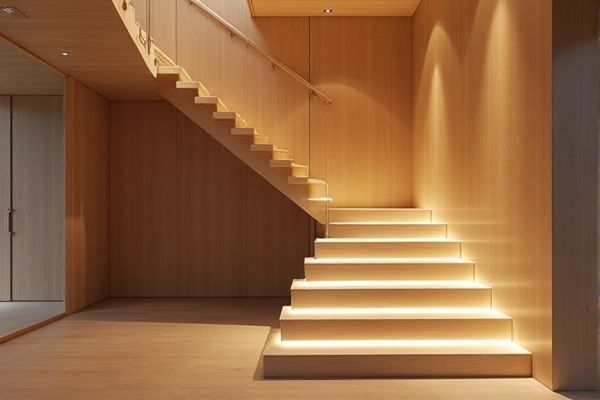
Floor-lit staircases provide subtle illumination from beneath each step, enhancing safety while creating a modern and sophisticated ambiance, whereas wall-lit staircases use mounted fixtures to cast light directly onto the steps, offering more focused visibility and design flexibility. Explore the rest of the article to discover which lighting option best suits Your home's style and functionality.
Table of Comparison
| Feature | Floor-Lit Staircase | Wall-Lit Staircase |
|---|---|---|
| Lighting Source | Lights embedded in stair treads or risers | Lights mounted on or recessed into walls alongside stairs |
| Illumination Coverage | Directly lights each step for enhanced foot visibility | Provides ambient or directional lighting along stair pathway |
| Safety | High safety due to clear step definition, reduces tripping | Moderate safety, may create shadows on steps |
| Installation Complexity | Requires wiring within steps; higher installation effort | Easier installation on walls; less invasive |
| Maintenance | Potentially higher, repairing embedded lights is challenging | Lower maintenance, lights are accessible on walls |
| Design Aesthetics | Modern, sleek look with subtle floor glow | Versatile design options with visible fixtures |
| Energy Efficiency | Typically uses low-voltage LED lights | Also uses LED technology; efficiency depends on fixture type |
| Cost | Generally higher due to complex installation and materials | Lower to moderate cost; easier to upgrade or change |
Introduction to Staircase Lighting
Floor-lit staircases incorporate lighting fixtures installed directly in the stair treads or risers, providing subtle illumination that enhances safety and highlights each step. Wall-lit staircases feature lights mounted along adjacent walls, casting light across the stairway surface and creating an ambient glow that improves visibility. Both lighting styles contribute to aesthetic appeal and functionality, with floor lighting offering discreet guidance and wall lighting emphasizing architectural design.
Understanding Floor-Lit Staircases
Floor-lit staircases feature lighting installed directly into the steps or risers, providing subtle illumination that enhances safety by clearly defining each stair edge. This design minimizes shadows and offers a modern aesthetic, making it ideal for both residential and commercial spaces seeking a sleek, unobtrusive lighting solution. Understanding the benefits of floor-lit staircases helps you choose efficient lighting that improves visibility without compromising style.
Exploring Wall-Lit Staircases
Wall-lit staircases create a modern ambiance by embedding LED strips or sconces directly into the wall, providing consistent illumination that enhances safety and aesthetic appeal. Unlike floor-lit stairs that highlight each step from below, wall lighting reduces shadows and glare, offering clearer visibility across the entire staircase. You can choose various designs and color temperatures in wall-lit options to complement your interior while ensuring functional lighting.
Aesthetic Impact: Floor vs Wall Lighting
Floor-lit staircases create a dramatic and modern ambiance by casting upward glows that highlight each step's texture, enhancing safety and visual appeal. Wall-lit staircases offer a softer, indirect illumination that emphasizes architectural details while maintaining a cozy, elegant atmosphere. Choosing between floor and wall lighting depends on the desired aesthetic effect, with floor lighting providing bold contrast and wall lighting delivering subtle sophistication.
Safety and Visibility Considerations
Floor-lit staircases enhance safety by illuminating each step directly, reducing the risk of missteps and improving visibility in low-light environments. Wall-lit staircases provide ambient lighting that highlights the staircase's edges and wall contours, offering a softer illumination that can guide your movement without causing glare. Choosing between the two depends on your need for precise step visibility versus a more subtle lighting effect that complements your interior design.
Installation Requirements and Complexity
Floor-lit staircases require precise embedding of lighting fixtures into the stair treads or risers, often demanding professional expertise to ensure electrical safety and waterproofing, especially in outdoor or high-traffic areas. Wall-lit staircases involve mounting fixtures along the staircase walls, which typically simplifies installation by avoiding direct interference with the steps but requires careful wiring concealment and may necessitate wall reinforcement. Your choice depends on the balance between desired aesthetic impact and the feasibility of installation within your architectural constraints.
Energy Efficiency and Maintenance
Floor-lit staircases use recessed LED lights embedded in the steps, offering focused illumination with minimal energy consumption, often rated under 5 watts per fixture. Wall-lit staircases typically require higher wattage bulbs to adequately light vertical surfaces, potentially increasing overall electricity usage. Maintenance for floor-lit options involves periodic cleaning of fixture lenses and occasional LED replacements with long lifespans, whereas wall-lit setups may demand more frequent bulb changes and access for fixture cleaning.
Cost Comparison: Floor-Lit vs Wall-Lit
Floor-lit staircases generally entail higher installation costs due to wiring and recessed fixture requirements, while wall-lit staircases tend to be more budget-friendly with simpler mounting options. Energy consumption varies less between the two, but floor lights may involve higher maintenance expenses if fixtures are embedded into the flooring material. Your choice should consider both upfront investment and long-term upkeep when weighing floor-lit versus wall-lit staircase options.
Ideal Applications and Use Cases
Floor-lit staircases are ideal for outdoor pathways, garden steps, and commercial spaces where ground-level illumination enhances safety and aesthetic appeal. Wall-lit staircases suit indoor environments, such as residential halls and office buildings, providing subtle, space-saving lighting that guides your steps without glare. Your choice depends on the location and design goals, balancing visibility with architectural style.
Choosing the Optimal Staircase Lighting Solution
Floor-lit staircases enhance safety by illuminating each step from below, reducing shadows and ensuring clear visibility. Wall-lit staircases offer a sleek, minimalist aesthetic by casting light across the stair tread and riser, highlighting architectural features. Selecting the optimal staircase lighting depends on spatial layout, desired ambiance, and energy efficiency considerations, with LED technology playing a vital role in both solutions.
 homyna.com
homyna.com